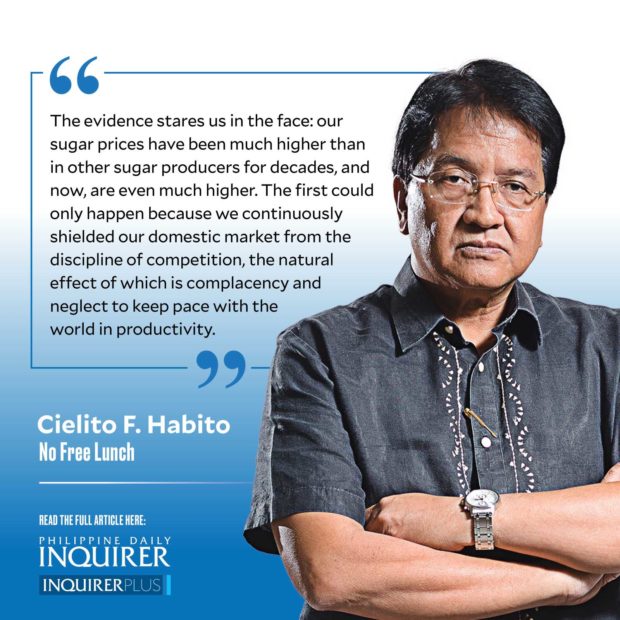Hard facts on sugar
 So much has been written on the so-called “sugar mess” in the past two weeks that I hesitated to add more. But I thought it might help if we distilled the cold hard facts from opinions, accusations, and impressions, as so many of these seem to be flying about. The specific issue at hand boils down to the question: Should sugar imports be allowed?
So much has been written on the so-called “sugar mess” in the past two weeks that I hesitated to add more. But I thought it might help if we distilled the cold hard facts from opinions, accusations, and impressions, as so many of these seem to be flying about. The specific issue at hand boils down to the question: Should sugar imports be allowed?
Fact 1: Domestic Philippine sugar prices have consistently been much higher than international prices for well over two decades, and the gap has widened in more recent years. Time-series data compiled from the Sugar Regulatory Administration (SRA), World Bank, and US Department of Agriculture show Philippine raw sugar prices to have consistently been 1.3 to 2.4 times higher than both the world price and Thailand’s price from 2001 to 2019. Thailand’s and world prices have moved closely together, indicating that Thailand has managed to keep up with world productivity levels, whereas the Philippines has consistently suffered much lower productivity, hence much higher costs.
Fact 2: Sugar productivity in the Philippines, both in the farms and in the mills, lags well behind that of other major world sugar producers. The Brain Trust Inc. sugar industry study for the National Economic and Development Authority cites comparative data showing inferior farm productivity in the Philippines. Against our 60-65 tons of cane yield per hectare, Thailand, India, and Brazil average 70-75 tons, and Australia manages 75-80 tons. Thailand also recovers 15 percent more than our milled sugar yield of 5.1 tons per hectare, while China gets 36.5 percent more, Australia 45 percent more, and Brazil 58 percent more, according to data compiled by UP Los Baños agronomist Dr. Teodoro Mendoza.
Fact 3: Official government data report a substantial drop in domestic sugar production in 2022. The national income accounts from the Philippine Statistics Authority post a steep 27.6 percent year-on-year drop in sugarcane production as of the first half of 2022. The website of the SRA similarly shows a 346,046 metric ton (MT) drop in sugar production from the 2020-2021 September to July period, to the same period in 2021-2022 (i.e., from 2,138,147 MT to 1,792,102 MT). Total supply, which includes starting inventories, likewise dropped by 348,504 MT (from 2,392,910 MT to 2,044,406 MT). Total physical sugar stocks were down by 135,192 MT (from 281,586 MT to 143,394 MT). All the numbers point to a clear and significant decline in domestic sugar production over the past year. Numbers don’t lie, and nor do our professional statisticians; there’s clearly a domestic sugar supply problem this year.
Fact 4: The gap between Philippine sugar price and that in Australia, Brazil, and Thailand—already wide as it is—has suddenly widened even more in 2022. This year, the wholesale price of raw sugar in the Philippines is 2.7 times Brazil’s, 3.1 times Australia’s, and 4 times Thailand’s corresponding prices. In the past five years, the same ratio had averaged only 2.3 times for Brazil, 2.2 times for Australia, and 2.8 times for Thailand. For refined sugar, the Philippine price is now 3 times Brazil’s and 4.2 times Thailand’s price, whereas the average ratios for the last five years were 2.4 and 2.8 times, respectively. Thus, the latest sugar price hikes in the Philippines must trace to more than higher production costs caused by international disruptions that pushed up prices of fertilizers and other farm inputs.
The evidence stares us in the face: our sugar prices have been much higher than in other sugar producers for decades, and now, are even much higher. The first could only happen because we continuously shielded our domestic market from the discipline of competition, the natural effect of which is complacency and neglect to keep pace with the world in productivity. This year’s even wider gap is evidence of a supply shortfall that continuing import restrictions can only heighten. The moral lesson: excessive trade protection stifles the impetus (of both producers and government) to invest in higher productivity—and this goes well beyond sugar.
And that, my friends, is the continuing story of Philippine agriculture.
—————–
cielito.habito@gmail.com




















